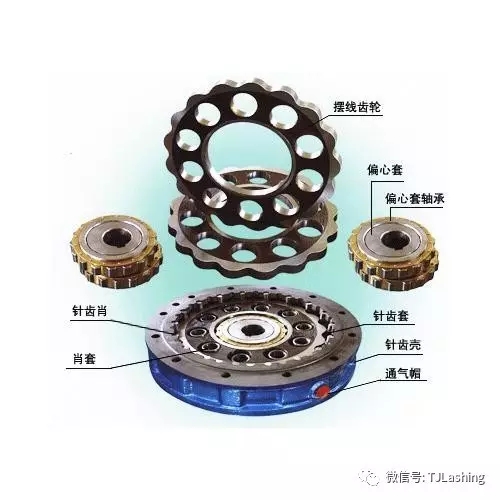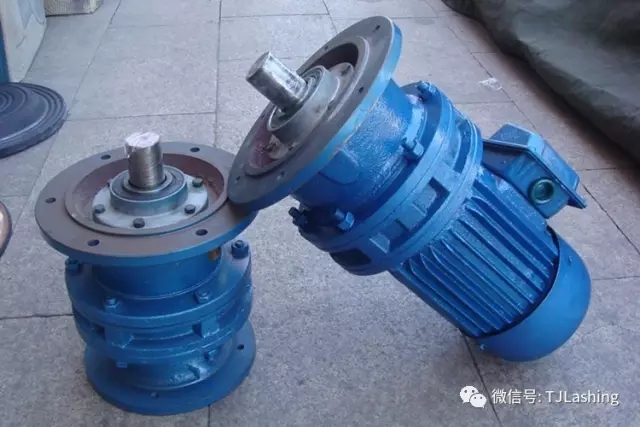The cycloidal pinwheel reducer is widely used as a small and complex internal rotating device. In order to improve the work efficiency and service life of the cycloidal pinwheel reducer, it is necessary to analyze some common fault problems during operation from the perspectives of installation, use, and maintenance, and propose relevant maintenance skills and effective methods for handling faults.
1. Common problems during installation of cycloidal gear reducers

The size of the cycloidal gear reducer itself is small, making it easy to connect between devices. However, due to the existence of various forms of connections, there are many details to pay attention to during installation to ensure the normal operation of the cycloidal gear reducer and other equipment. Mainly analyzed from the following four aspects:
(1) The output shaft in the output device of the cycloidal pinwheel reducer can withstand limited axial impact force. It is not advisable to use the shaft end screw for installation, screw in the connecting parts, and directly hammer the reducer.
(2) During installation, it is necessary to ensure the high fit of the corresponding dimensions of the reducer, including the standard and horizontal height of the installation centerline, to ensure that the concentricity of the reducer is within the strict standard range.
(3) In the rotation of the lubrication system of the equipment itself, it is also necessary to fully consider the actual working environment of the reducer and the production needs of the oil pump to meet the lubrication of various parts of the reducer.
(4) To ensure that the appearance of the reducer body does not deform during installation, provide a horizontal working position and symmetrically arrange the bolts of the cushion blocks. In addition, in order to prevent oil leakage during operation of the gearbox, it is required to control the inclination angle of the gearbox within 15 degrees during installation.
2. Analysis of common problems during use
In the actual use process, certain principles should be followed and used correctly under the required conditions. In addition, it is also necessary to consider issues such as lubricating oil, voltage, and usage location.
Firstly, in terms of usage conditions, two points need to be noted:
(1) The cycloidal gear reducer can achieve continuous operation and can operate in two opposite directions.
(2) The axial and radial forces that the output equipment of the reducer can withstand need to be controlled within a certain range. When the bearing force is large, appropriate measures need to be taken to ensure that the output equipment can operate normally.
Secondly, from the perspective of usage, problems often occur in the following situations:
(1) The motor of the cycloidal pinwheel reducer needs to operate normally at rated voltage.
(2) When selecting suitable lubricating oil for the cycloidal needle gear reducer, it is necessary to comprehensively consider the actual operating environment and always pay attention to the operating temperature of the reducer to avoid other equipment hazards and even bearing damage caused by high oil temperature.
(3) In addition to selecting appropriate fuel and lubricating oil, in actual operation, personnel also need to pay attention to the remaining oil in the gearbox, and timely replenish the gearbox with fuel to avoid damage caused to the gearbox, ensure its normal operation, and extend its service life.
(4) During the specific refueling process, in addition to replacing the gearbox with new oil after 100 hours of operation for the first time, the replacement work is carried out every six months. If the operating environment is poor, the replacement cycle needs to be appropriately shortened.
(5) Regular and careful equipment cleaning and replacement with new oil can extend the service life of the gearbox to a certain extent and improve work efficiency.
。

3. Analysis of common problems in the maintenance process of the gearbox
The internal structure of the gearbox is complex. In order to ensure its work efficiency and extend its service life, regular maintenance and repair are required. Here, common problems are listed and analyzed from the perspectives of regular inspection and appropriate maintenance.
From a regular inspection perspective, it can be carried out from the following four aspects:
(1) The tightness and concentricity of the reducer coupling are very important for the operation of the reducer. It is necessary to control the two indicators of tightness and concentricity in order to effectively avoid serious damage caused by the equipment under flying torque force.
(2) It is necessary to regularly check the basic device condition of the reducer, such as device installation, screw fixation, operation, etc., to ensure that the reducer can achieve balanced movement, and to adjust or reinstall unreasonable screws in appropriate positions.
(3) The oil level of the gearbox should be controlled within a standard range. If it falls below this standard, it should be added, and it should not be too high or too low to ensure the normal operation of the gearbox.
(4) After using the gearbox for a period of time, replace it with new oil as needed, and clean the metal powder in the gearbox. However, it is important to note that the amount of oil added should ensure that the gearbox can operate normally and play a significant role in lubrication.
From the perspective of appropriate maintenance, the following six aspects need to be noted:
(1) For parts in the equipment that are prone to corrosion, such as shaft sealing rings, they are prone to aging and wear. During the operation of the reducer, the smoothness and sealing of the two contact areas can be ensured, and the noise generated during operation can be reduced. Regular inspection and replacement of the shaft sealing rings are necessary. In addition, the wear of the shaft sealing ring can easily cause dust or some metal powder from the working environment to enter the interior of the reducer.
(2) When the operating temperature of the reducer exceeds the bearing usage temperature, it is necessary to stop the machine for inspection and carefully check whether there is any damage to the bearings, gear sleeves, flower discs, spacing rings, pin sleeves, and other parts of the reducer. If there is a certain degree of deformation or damage, it needs to be replaced in a timely manner, and attention should be paid to correct installation during replacement.
(3) During normal operation of the reducer, the eccentric shaft bears a large force, and the eccentric bearing should be replaced in a timely manner during disassembly and maintenance.
(4) When the gearbox is unpacked for maintenance and inspection, the reinstallation process must be cautious and careful. After wiping the contact surface clean, replace the sealing gasket with sealant with a suitable thickness.
(5) The internal structure, parts, and equipment parameters corresponding to different gearbox models are different, and internal parts cannot be replaced or pieced together with other gearbox parts during maintenance.
Due to the different conditions, operating environment, and operating time of the gearbox, various faults may occur during actual operation. Strict installation and operation standards are required for the installation, use, and maintenance of the gearbox. In addition, relevant staff should pay more attention and fully reflect the advantages of the cycloidal needle wheel reducer to improve work efficiency.





